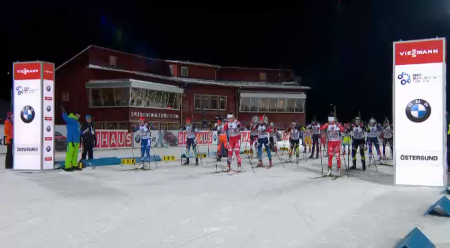
This year, the International Biathlon Union (IBU) approved a major new rule change. Instead of a start zone ten lanes wide for relays and mass starts, with a designated 50-meter double pole zone, the width of the start would be reduced to three lanes and skiers would be able to skate immediately.
The idea was that the start would be more smooth: a pack would already be formed, skiers could still move up, but there wouldn’t be the sometimes-messy period of ten skiers fighting for position as the trail quickly narrows.
With at least two kilometers before the first shooting, technical organizers assumed that there would be space for things to shake out. And if not, well, shooting presents an opportunity to make up lost ground.
The format got its first test this weekend in the World Cup mixed relay in Östersund, Sweden. How did it work? Things appeared to go smoothly, and there were certainly no obvious tangle-ups.
But when we talked to the two North American women who skied leadoff legs, Susan Dunklee of the United States and Rosanna Crawford of Canada, neither were fully convinced that the format should stick around.
“It’s strange,” Dunklee said. “Basically I think it’s designed to give the teams that are ranked higher an advantage, giving them the first spot off the line. Instead of ten people across it’s only three. It made it a little less stressful in some ways, that start – you don’t have as much room to maneuver, there’s not as much opportunity to move up, but there’s not as much potential for falling back either I guess.”
Both she and Crawford had smooth starts and were near the front by the time they hit the range; with good shooting, Crawford took the lead on the second lap, while Dunklee briefly led on the third lap. The two had started with bibs nine and eleven.
Crawford chalked it up to luck.
“I guess it will depend course by course if it’s going to work out or not,” she said. “But definitely for strong people from bib 10 onwards, it’s a bit of a fight to get to the front.”
And for those even farther back, it might be significantly worse.
“Kaisa [Makarainen of Finland] and I talked a little bit in the finish area,” Crawford said. “She really didn’t like it, being bib 20 she was a lot further back and had to work really hard to get to the front.”
Indeed, when Makarainen finally popped into view in the final few hundred meters of the first lap, it was like a revelation – viewers on television wouldn’t have even known she was in the race before that, because she was so far from the lead.
“I think it would have made a little more sense to go down to five or six people per row instead of three,” Dunklee said.
Seeing the experience of Makarainen and others, she is worried for her own team. The U.S. only brought three women to Europe for the first period of racing, so will not be able to compete in relays. That means they will miss out on valuable Nations Cup points and be seeded farther back when they finally do get to field a team.
“I’m a little bummed because we’re going to have to sit out the first few women’s relays because we don’t have four people here, so when we get to World Championships we will be starting way in the back of that race because of this,” Dunklee lamented. “I guess you just have to shoot well in the first stage and pass a bunch of people.”
In the past, it hasn’t been as much of an issue. A strong double-poler with smart tactics could quickly move close to the front in the old format.
“I think I’ve always been pretty good tactically when it comes to the start of races, when it comes to double-poling and dodging people and telling where people will go,” said Crawford, whose team has rarely been ranked in the top ten but who frequently turns in strong leadoff relay legs.
It looks like a determined skier, like Makarainen, can move up – and good shooting can help too. Both Dunklee and Crawford proved their chops.
But it will still be a tough road for late-seeded teams.
“We went immediately to skating and I was about 20 meters back from the first row,” Makarainen told Finnish news service YLE. “During the first lap I didn’t have room to move.”
When a race comes down to a photo finish like in Sunday’s relay, those 20 meters could mean the difference between winning and losing.
Chelsea Little
Chelsea Little is FasterSkier's Editor-At-Large. A former racer at Ford Sayre, Dartmouth College and the Craftsbury Green Racing Project, she is a PhD candidate in aquatic ecology in the @Altermatt_lab at Eawag, the Swiss Federal Institute of Aquatic Science and Technology in Zurich, Switzerland. You can follow her on twitter @ChelskiLittle.




One comment
helioguy
December 5, 2014 at 7:57 pm
The new start format will make life a lot easier for organisers and the stadium set up. Making ten perfect tracks was very difficult, time consuming, and took a lot of space. If the stadium is kind to spectators, and compact, there is often not enough room for the ten tracks. Now the start area will fit into a standard 10M start lane.
As to starting several meters back from the front, all that is required to take the front of the pack is to shoot fast and perfectly on the first prone. The race is not won on the first, or second or even the third leg, but at the finish line! This start without double poling will result in less broken poles and skiers cut off as they enter the squeeze zone into the standard trail width.
Looking forward to the season!